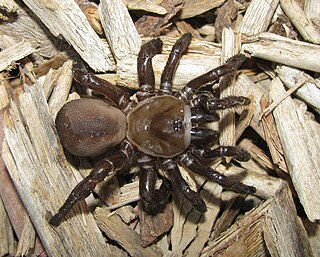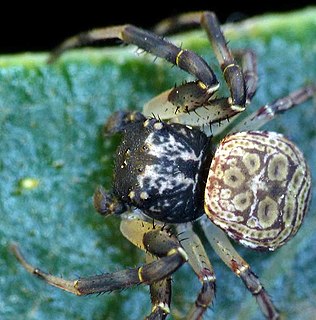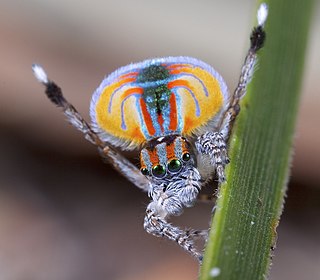 W
WBothriocyrtum californicum, the California trapdoor spider, is a species of spider in the family Halonoproctidae. It is found in the United States.
 W
WCastianeira walsinghami is a species of true spider in the family Corinnidae. It is found in the United States and Canada.
 W
WCeraticelus fissiceps is a species of dwarf spider in the family Linyphiidae. It is found in the United States and Canada.
 W
WCteniza moggridgei is a species of trapdoor spider found in France and Italy. On the Ionian Islands, their nests are often found among the roots of olive trees. These nests are sometimes found clustered together, but their proximity is not necessarily a sign of their sociality.
 W
WCymbacha saucia is a crab spider found in Australia. The body length of the female is up to 7 mm, the male 4 mm. A cryptic small species, the colour is usually brown, grey and black. Often found in a folded leaf, used as a retreat.
 W
WMaratus speciosus, sometimes called the coastal peacock spider, is an Australian species of jumping spider. They are only known to inhabit the vegetation of the coastal sand dunes of southwestern Western Australia. Like other Maratus spiders, the males of the species engage in a courtship display during which they raise their third pair of legs and their abdomen, presenting their colorful opisthosomal plate to potential female partners. Unlike other Maratus, however, the males of this species have a set of bright orange hairs (setae) along both edges of the opisthosoma which only become visible during this display.
 W
WMaratus volans is a species in the jumping spider family (Salticidae), belonging to the genus Maratus. Males of this species are characterized by colorful abdomen flaps that are used, along with courtship dances, to attract females. These spiders are native to Australia and have a specialized visual system that allows them to detect and pursue prey.
 W
WPhysocyclus globosus, sometimes known as the short-bodied cellar spider is a species of spider belonging to the family Pholcidae. This is a cosmopolitan species, found in caves and buildings throughout the warmer parts of the world.
 W
WSelenocosmia crassipes, synonym Phlogius crassipes, also known as the "Queensland whistling tarantula" is a species of tarantula native to the east coast of Queensland, Australia. The name "whistling tarantula" comes from its ability to produce a hissing noise when provoked, a trait it shares with other Australian theraphosids. This hissing is produced by the spider stridulating a patch of setae associated with its chelicerae. It has also been called the "eastern tarantula". The species name crassipes is Latin for "fat leg" referring to the relatively fat front legs.
 W
WSidymella rubrosignata is a species of crab spiders found in Australia. It is a common spider, often seen on Dianella plants.
 W
WTetragnatha montana, commonly known as the silver stretch spider, is a species of long-jawed orb weaver from the family Tetragnathidae that has a Palearctic distribution. It preys mostly on flies and mosquitoes. The name silver stretch spider refers to its shiny metallic colour and its habit of extending its legs into a stick like shape.
 W
WTitanoeca nivalis is a species of araneomorph spider in the family Titanoecidae. It has a Holarctic distribution.
 W
WWalckenaeria directa is a species of dwarf spider in the family Linyphiidae. It is found in the US and Canada.